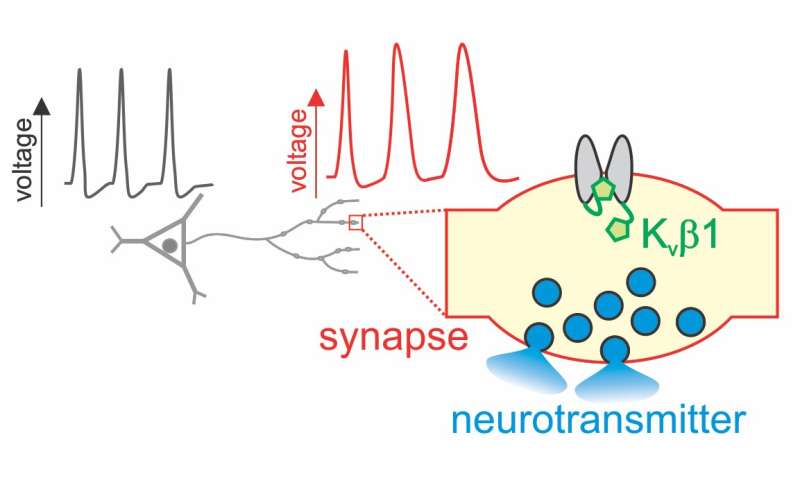
[ad_1]

A “molecular volume knob” made up of analog signals (red) regulates electrical signals in the brain to support learning and memory. Credit: Michael Hoppa.
A “molecular volume knob” regulating electrical signals in the brain helps learning and memory, according to a Dartmouth study.
The molecular system controls the width of the electrical signals that travel through synapses between neurons.
Uncovering the controlling mechanism and identifying the molecule that regulates it could help researchers find ways to manage neurological disorders, including Alzheimer’s disease, Parkinson’s disease and epilepsy.
The research, published in Proceedings of the National Academy of Sciences, describes the first study on how the shapes of electrical signals contribute to synapse function.
“Our brain’s synapses are very dynamic and speak in a range of whispers and cries,” said Michael Hoppa, assistant professor of biological sciences at Dartmouth and head of research. “This discovery puts us on a straighter path to being able to cure stubborn neurological disorders.”
Synapses are tiny points of contact that allow neurons in the brain to communicate at different frequencies. The brain converts the electrical inputs from neurons into chemical neurotransmitters that travel through these synaptic spaces.
The amount of neurotransmitter released changes the number and configuration of activated neurons in brain circuits. This overhaul of the strength of the synaptic connection is how learning occurs and how memories are formed.
Two functions support these memory and learning processes. One, known as facilitation, is a series of faster and faster spikes that amplify signals that change the shape of a synapse. The other, depression, reduces signals. Together, these two forms of plasticity keep the brain in balance and prevent neurological disorders such as seizures.
“As we age, it is essential to be able to maintain strengthened synapses. We need a good balance of plasticity in our brain, but also stabilization of synaptic connections,” said Hoppa.
Research has focused on the hippocampus, the brain center responsible for learning and memory.
In the study, the research team found that the electrical spikes are delivered as analog signals, the shape of which impacts the extent of the chemical neurotransmitter released across synapses. This mechanism works similarly to a dimmer with variable settings. Previous research viewed spikes as a digital signal, more like a light switch that only works in the “on” and “off” positions.
“The discovery that these electrical spikes are analog unlocks our understanding of how the brain works to train memory and learning,” said In Ha Cho, postdoctoral fellow at Dartmouth and first author of the study. “The use of analog signals provides an easier way to modulate the strength of brain circuits.”
Nobel laureate Eric Kandel conducted work on the link between learning and shape-shifting of electrical signals in marine sea slugs in 1970. The process was not thought to occur in the more complex synapses found. in the brain of mammals at the time.
In addition to discovering that the electrical signals that pass through synapses in the cerebral hippocampus are analog, Dartmouth’s research also identified the molecule that regulates electrical signals.
The molecule – known as Kvβ1 – has previously been shown to regulate potassium currents, but was not known to have a role in the synapse controlling the shape of electrical signals. These results help explain why the loss of Kvβ1 molecules previously negatively impacted learning, memory and sleep in mice and fruit flies.
Research is also revealing the processes that allow the brain to have such high computing power at such low energy. A single analog electrical pulse can carry multi-bit information, allowing better control with low frequency signals.
“It helps us understand how our brains are able to operate at supercomputer levels with much lower electrical pulse rates and the energy equivalent of a refrigerator light bulb. The more we learn about these levels of control, it helps us learn how our brains are so efficient, ”Hoppa said.
For decades, researchers have searched for molecular regulators of synaptic plasticity by focusing on the molecular machinery of chemical release. Until now, measurements of electrical impulses were difficult to observe due to the small size of the nerve endings.
The new research result was made possible by technology developed at Dartmouth to measure the tension and release of neurotransmitters with techniques using light to measure electrical signals in synaptic connections between neurons in the brain.
In its future work, the team will seek to determine how the discovery relates to changes in brain metabolism that occur during aging and cause common neurological disorders.
According to the research team, the molecular system exists in an area of the brain that is easily targeted by pharmaceuticals and that may be suitable for the development of drug therapies.
Scientists reveal how the brain can fuel intense neural communication
In Ha Cho et al. The Kvβ1 subunit of the potassium channel serves as a major control point for synaptic facilitation, Proceedings of the National Academy of Sciences (2020). DOI: 10.1073 / pnas.2000790117
Provided by Dartmouth College
Quote: Research identifies ‘volume control’ in the brain that supports learning and memory (November 10, 2020) Retrieved November 11, 2020 from https://medicalxpress.com/news/2020-11- volume-brain-memory.html
This document is subject to copyright. Other than fair use for private study or research purposes, no part may be reproduced without written permission. The content is provided for information only.
[ad_2]
Source link